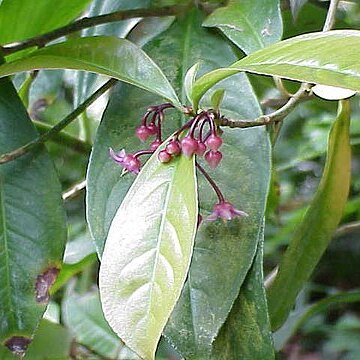Shrubs, 1-4.5 m high, the branchlets usually thick, glabrous. Leaves petiolate, the petioles to 15 mm long, usually shorter, marginate; leaf blades oblanceolate, obovate, or oblong-elliptic, 7.5-15 cm long and 2.5-6 cm wide, widely acuminate or obtusish apically, narrowed and basally acute, decurrent, chartaceous, the venation fine, sometimes conspicuously reticulate, the costa plane or nearly so above, elevated beneath. Inflorescences axillary (also see A. pleurobotrya), long-pedunculate with 1 corymb apically, few-flowered, glabrous. Flowers 5-merous, subcorymbose, the pedicels stout, rigid, 1-3 cm long; flowers at anthesis 7-8 mm long, the buds acute; sepals free, depressed-ovate, suborbicular or reniform, 2-3 mm long, punctate, ciliolate at first; petals connate basally, ovate-elliptic or oblong-elliptic, asymmetrical, punctate with small dispersed glands; stamens ca. 6 mm long, the filaments 1-2 mm long, the anthers lanceolate, to 5.5 mm long, conspicuously black-punctate dorsally, tapered to an acute apex; ovary glabrous, ovoid, the ovules numerous, pluriseriate, the style ca. 6 mm long.
More
A shrub about 2-6 m high. The small branches are angular. They are 5-7 mm across. The leaves have leaf stalks. These are 1-2 cm long. The leaves are 6.5-22 cm long by 2.9-9.5 cm wide. They are oval or oblong. There are about 20 side veins each side of the midrib. They are raised on both surfaces. The flowers are pink. They are leathery and about 1 cm long. The fruit are round and black when ripe. They are 7-9 mm across.
The ripe fruit are eaten raw. They are used for drinks. The young leafy shoots are parboiled, washed, drained and seasoned for eating in salads. The flowers are eaten as a vegetable.

